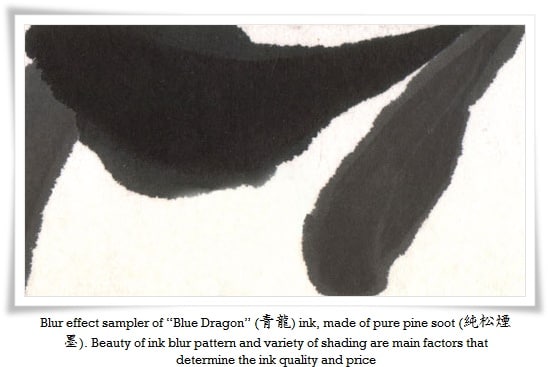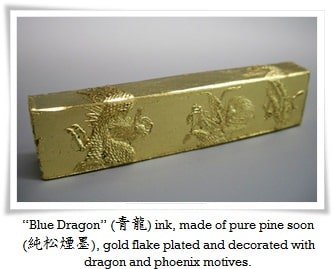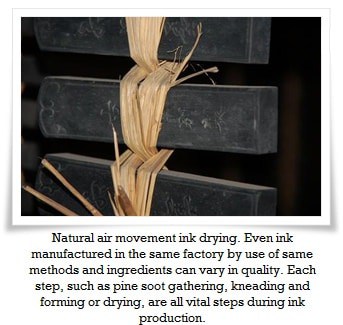Before buying ink we need to ask ourselves the question of what purpose it will serve, or what effect we want to achieve. For example, red ink (朱墨, shuboku), is used mainly by teachers to mark and correct works of their students, or on stones before carving. Silver (銀墨, ginboku) or gold (金墨, kinboku) can be used for copying sutras. Writing with gold ink on red paper is a Chinese New Year’s tradition. In Japan, experimenting with different shades of ink (black to very light grey) is very popular. “Tea ink” (茶墨, chaboku), thanks to its delicate shading, is commonly used in kana (かな) calligraphy.
There are three main things to check while purchasing ink stick.
- It needs to be well kneaded. Well kneaded ink is usually thicker (denser) than others, and it also has a uniform structure. It is said that ink sticks coming from the same factory but different production series can vary greatly.
- It needs to be well dried by natural air movement. By gently tapping an ink stick against another one or by flicking it with a fingernail a well dried ink delivers a clear metallic sound.
- Its surface needs to be smooth and free of flaws. If the ink surface has lumps or wrinkles it means that it was not well mixed and soot particles used for its production were poorly gathered. Cracked ink means that it is too dry and that the ink was not dried by the natural motion of air. It may chip during ink grinding and damage the work, brush or even the inkstone.
The aesthetic value of ink used for practical use are rather a secondary factor, nonetheless it is advisable to purchase ink that is suitable for grinding (size and shape wise) and preferably not lavishly decorated. Ink in a circular shape will be difficult to grasp, and ink which is too small in its cross section, will extend preparation time.
Old ink (古墨, koboku) is lighter (weight wise) and darker, and also less sticky than newly made ink. During writing, both the blur and the centre of the line will apply very well, as well as kasure (掠れ, streaks of white), and will be harmonious and produce a beautiful colour.
New ink will be stickier, and thus its application will be not as smooth as koboku. It is because the animal glue, which is one of the main components of the ink, is still very “active”.
Aged ink is best, though being too old is not always good. However, with today’s technology, it is possible to produce new ink that has similar quality and attributes to that of the naturally aged ink.
Cheap inks are produced out of petroleum oil and should be avoided, for they are of inferior quality and lack in purity. Also, they will affect not only the artistic and spiritual value of calligraphy, but also its durability over time.



